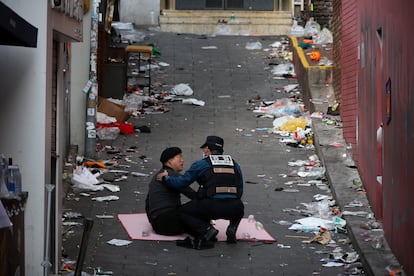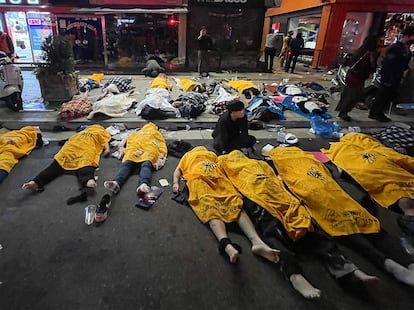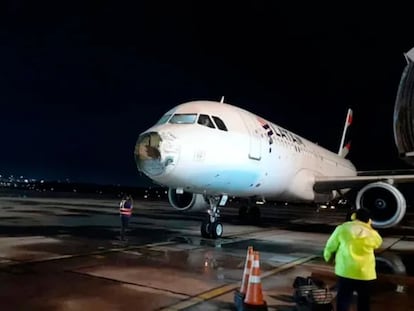Eyewitness in Itaewon: ‘Dad, there’s been a stampede in Seoul. I think a lot of people have died’
A 20-year-old Spanish journalism student living in the South Korean capital recounts the Halloween night tragedy in which at least 154 people died

The Itaewon subway station in Seoul augured a tragic night at 9pm on Saturday October 29, as Koreans went out to celebrate Halloween for the first time since the coronavirus pandemic struck. The faces of thousands of young people were hidden under masks and make-up of every kind. Zombies, vampires and superheroes emerged from the subway with the help of the police and transport workers. In the street, improvised make-up stalls and queues for nightclubs merged on the packed sidewalks as hundreds of cellphones recorded the festivities, making passage along the street more difficult in a district famed for its nightlife and huge crowds.
A few steps from the subway entrance, a nightmare that would lead to the loss of over 150 lives was brewing in a sloping alley just four meters wide. Many people were moving up the alley towards Atelier, one of the most famous clubs in the Itaewon neighborhood, while others were fleeing the other way towards the main avenue, away from what was already becoming a terrifying situation. Local media reports stated that the crowds began to push in the narrow alley, near the Hamilton Hotel, with eyewitnesses recounting how several people towards the top of the side street fell, causing a domino effect downhill.
A 20-year-old student who had reached the middle of the street looked fearfully at her friends and asked them to turn around as she could progress no further. To her right, several more people were blocked in, at the mercy of gravity and the decisions of an increasingly uncontrollable mass of people. The catastrophic situation was exacerbated by still more people entering the street, unaware of what was unfolding. Their focus was on Atelier’s illuminated entrance, visible at the end of the street. Without time to react, they too became trapped in the alley.
The stampede did not come suddenly: the volume of people in the street had been steadily increasing until it was impassable and the sensation of fear had been growing at the same rate until there was no longer any viable way out. At round 10.30pm, the first calls to the emergency services and shouts from the crowd alerted passers-by and police in the area. The paramedics had not yet arrived and a heroic group of citizens and police struggled against the tide to pull those people nearest to them to safety. Meanwhile, emergency responders were arriving on the scene, asking members of the public to perform CPR on the first victims.

The situation swiftly deteriorated and the capacity of the emergency services to counter it was limited. A young Frenchman later described it as the most terrifying experience of his life. He had attempted unsuccessfully to resuscitate two young women of around his age. He had never received any CPR training but there were only enough defibrillators for every 10 to 15 people.
Terror set in and the narrowness of the alley and the desperate attempts of people to save themselves made the rescue of the worst-affected even more difficult. Some people attempted to escape the crush by climbing up and over the walls of the street.
In the nearby nightclubs, the music and the dancefloors, awash with alcohol and post-covid euphoria, presented a parallel reality to what was taking place outside. Time was also relative, passing swiftly inside while outside every second was a hellish struggle to stay alive. Cellphones began to buzz across the neighborhood at around 11pm as the authorities issued an emergency alert: “Traffic is currently being diverted from Itaewon due to an emergency. Please turn your vehicles around.”
At that moment, few people paid much attention: it didn’t seem to the majority that anything serious was happening. It was only when people went outside to some a cigarette or buy a beer that they became aware of the scale of the tragedy. Ambulances, firefighters and police had taken over the area. The music blaring from clubs that were starting to empty provided the soundtrack to a horrific and chaotic scene. Young people who had arrived by subway for a night of entertainment were being taken away in ambulances. Costume masks no longer covered their faces. Instead, a row of blankets lay over dozens of lives cut short in a tiny alleyway.
The cellphones that were earlier recording videos of the festival were now being used to reassure relatives and to try and locate missing friends. Calls to families were made by young people telling their parents and siblings that they had been lucky that day, that the decision to go to one club and not another had saved their lives. I wrote a text home: “Dad, there’s been a stampede in Seoul. I think a lot of people have died but I’m OK. We don’t know yet what happened exactly.” On the other end of the line, hundreds of families breathed a sigh of relief, but in Itaewon lay at least 154 people who would never breathe again.
Tu suscripción se está usando en otro dispositivo
¿Quieres añadir otro usuario a tu suscripción?
Si continúas leyendo en este dispositivo, no se podrá leer en el otro.
FlechaTu suscripción se está usando en otro dispositivo y solo puedes acceder a EL PAÍS desde un dispositivo a la vez.
Si quieres compartir tu cuenta, cambia tu suscripción a la modalidad Premium, así podrás añadir otro usuario. Cada uno accederá con su propia cuenta de email, lo que os permitirá personalizar vuestra experiencia en EL PAÍS.
¿Tienes una suscripción de empresa? Accede aquí para contratar más cuentas.
En el caso de no saber quién está usando tu cuenta, te recomendamos cambiar tu contraseña aquí.
Si decides continuar compartiendo tu cuenta, este mensaje se mostrará en tu dispositivo y en el de la otra persona que está usando tu cuenta de forma indefinida, afectando a tu experiencia de lectura. Puedes consultar aquí los términos y condiciones de la suscripción digital.
More information
Archived In
Últimas noticias
Welcome to the post-religion era: The idea of Christianity as the absolute truth has become obsolete
‘I thought you would like it’: The risky sexual practice popularized by TV shows and TikTok
The digitalization of tourism: ‘They promise experiences and gave us the worst possible one’
Mexican peso defies uncertainty with forecasts of a new period of stability in 2026
Most viewed
- Sinaloa Cartel war is taking its toll on Los Chapitos
- Oona Chaplin: ‘I told James Cameron that I was living in a treehouse and starting a permaculture project with a friend’
- Reinhard Genzel, Nobel laureate in physics: ‘One-minute videos will never give you the truth’
- Why the price of coffee has skyrocketed: from Brazilian plantations to specialty coffee houses
- Silver prices are going crazy: This is what’s fueling the rally










































